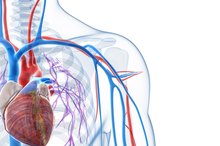What Are the Largest Blood Vessels in the Body?
Blood vessels deliver blood from the heart to the tissues, and return oxygen-depleted blood to the heart. The vascular system is made up of three vessel types. Arteries carry blood away from the heart, veins return blood to the heart, and the tiny capillaries connect arteries to veins, while also suffusing tissues with blood. The largest vessels in the body include arteries and veins.
If you are experiencing serious medical symptoms, seek emergency treatment immediately.
Aorta
Human circulation is subdivided into two categories, notes Dr. Lauralee Sherwood in her book "Human Physiology." Systemic circulation takes oxygenated blood from the heart to the body tissues, and the largest of the systemic circulation arteries is the aorta 1. Blood enters the aorta from the left ventricle of the heart by way of a one-way valve to prevent backflow. From the aorta, several arterial branches carry blood to the head, later branches carry blood to the arms, and then the aorta proceeds downward through the body as the abdominal aorta.
- Human circulation is subdivided into two categories, notes Dr. Lauralee Sherwood in her book "Human Physiology."
- From the aorta, several arterial branches carry blood to the head, later branches carry blood to the arms, and then the aorta proceeds downward through the body as the abdominal aorta.
Pulmonary Artery
How Long Does It Take Blood to Circulate?
Learn More
The second subdivision of human circulation is pulmonary circulation, which carries deoxygenated blood from the heart to the lungs for oxygen, and then returns it to the heart. In his book "Anatomy and Physiology," Dr. Gary Thibodeau notes that the largest of the arteries in pulmonary circulation is called the pulmonary artery, which exits the heart via a valve from the right ventricle 2. The pulmonary artery, which later branches, is the only artery in the body to carry deoxygenated blood.
Vena Cava
The systemic veins return deoxygenated blood from the tissues to the heart. Separate veins drain the lower and upper body, and these veins converge as they approach the heart. As such, the largest veins in the body are the ones that enter the right atrium of the heart. These veins, note Thibodeau, are called the superior and inferior vena cava. The superior vena cava drains the upper body and head, while the inferior vena cava drains the lower body.
- The systemic veins return deoxygenated blood from the tissues to the heart.
- Separate veins drain the lower and upper body, and these veins converge as they approach the heart.
Pulmonary Veins
The 4 Parts of the Cardiovascular System
Learn More
After blood picks up oxygen from the lungs, it must return to the heart. The veins of pulmonary circulation return this blood, eventually dumping it into the left atrium of the heart. As with systemic circulation, pulmonary veins converge and grow larger as they approach the heart. The largest of these veins, of which there are four, are called pulmonary veins. Notes Thibodeau, these are the only veins in the body to carry oxygenated blood.
- After blood picks up oxygen from the lungs, it must return to the heart.
- The veins of pulmonary circulation return this blood, eventually dumping it into the left atrium of the heart.
Related Articles
References
- “Human Physiology”; Lauralee Sherwood, Ph.D.; 2004
- “Anatomy and Physiology”; Gary Thibodeau, Ph.D.; 2007
- Kim SS, Shin HC, Hwang JA, et al. Various congenital anomalies of the inferior vena cava: review of cross-sectional imaging findings and report of a new variant. Abdom Radiol (NY). 2018;43(8):2130-2149. doi:10.1007/s00261-017-1430-y
- Petik B. Inferior vena cava anomalies and variations: imaging and rare clinical findings. Insights Imaging. 2015;6(6):631-9. doi:10.1007/s13244-015-0431-z
- Rajabnejad Y, Aliakbarian M, Rajabnejad A, Motie MR. Left-Sided Inferior Vena Cava Encountered During Organ Retrieval Surgery: Report of Two Cases. Int J Organ Transplant Med. 2016;7(4):229-232.
- Shammas NW, Rachwan RJ, Daher G, Bou dargham B. Double Inferior Vena Cava and its Implications During Endovascular and Surgical Interventions: A Word of Caution. J Invasive Cardiol. 2017;29(2):51-53.
- Rao B, Duran C, Steigner ML, Rybicki FJ. Inferior vena cava filter-associated abnormalities: MDCT findings. AJR Am J Roentgenol. 2012;198(6):W605-10. doi:10.2214/AJR.11.7664
- Byrne M, Mannis GN, Nair J, Andreadis C. Inferior vena cava filter thrombosis. Clin Case Rep. 2016;4(2):162-4. doi:10.1002/ccr3.418
- Inferior Vena Cava. Innerbody website. Updated December 2016.
- Inferior Vena Cava. Kenhub GmbH website.
- Inferior Vena Cava Filter Placement and Removal. Radiologyinfo.org website. Updated April 2018.
- Tucker, William D. Burns, Bracken. Anatomy, Abdomen and Pelvis, Inferior Vena Cava.: Treasure Island, FL: StatPearls Publishing; 2019.
Writer Bio
Kirstin Hendrickson is a writer, teacher, coach, athlete and author of the textbook "Chemistry In The World." She's been teaching and writing about health, wellness and nutrition for more than 10 years. She has a Bachelor of Science in zoology, a Bachelor of Science in psychology, a Master of Science in chemistry and a doctoral degree in bioorganic chemistry.





